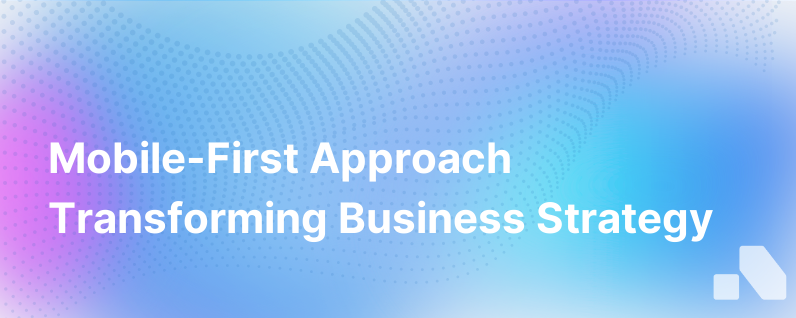Not Just Mobile Mobile First
Published on September 4, 2023 by Sawyer Middeleer
In the not-so-distant past, the term 'mobile-friendly' was enough to satisfy the requirements of a nascent, smartphone-obsessed demographic. That time, however, has passed. With mobile devices now the primary means of accessing the internet for billions globally, 'mobile-friendly' has evolved into 'mobile-first'. This approach isn't just a trend—it's a paradigm shift in our digital ecosystem that demands a reevaluation of how we engage users and design experiences.
The Emergence of Mobile-First
Mobile-first means that designing an exceptional mobile experience is no longer merely advantageous—it's imperative. The philosophy is simple but profound: when initiating any digital project, be it a website, an app, or an online tool, start with the mobile experience before scaling up to desktop or other larger devices.
Let's unpack the crucial principles that enterprises and creators must integrate into their DNA.
Priority of User Experience
Mobile-first is driven by an uncompromising focus on the user experience. Content must be accessible, navigation intuitive, and load times lightning-fast. Mobile users are typically on-the-go, which means they have less patience for sluggish or cumbersome sites. Mobile-first prioritizes the need for agile, streamlined interactions with a minimalistic yet engaging design philosophy.
Content Hierarchy and Structuring
A smaller screen necessitates smarter content prioritization. There's less real estate on a mobile device, forcing designers and content creators to think rigorously about the placement of elements. Content hierarchy in the mobile-first approach ensures that users are presented with the most valuable content prominently, with secondary information readily available but not cluttering the initial view.
Simplification and Optimization
Speed and simplicity reign supreme. Mobile-first designs account for slower mobile internet speeds and variable connection quality. Optimization includes image compression, efficient coding practices, and avoiding heavy scripts that might clog the mobile arteries. These practices result in a faster, more responsive experience that respects the user's time and data limits.
The Technical Backbone
Responsive design underpins the technical aspect of mobile-first by using fluid grids, flexible images, and media queries in CSS. This allows the content to resize smoothly across different screen sizes. Moreover, progressive enhancement—starting with a solid base and enhancing functionality for more capable devices—is a cornerstone of this approach.
The Impact and Importance of Mobile-First
Why is this approach gaining such importance? Consider these points:
-
Google’s Emphasis: The search engine giant has shifted to mobile-first indexing, meaning it looks at the mobile version of your content for indexing and ranking. Google's preference aligns directly with a mobile-first strategy, emphasizing the importance of mobile usability in search engine optimization (SEO).
-
User Behavior: According to various reports and analytics, most users now access digital content via mobile devices. A mobile-first design aligns with this behavior, creating an immersive and native experience for the majority of users.
-
Conversion Optimization: A well-executed mobile experience significantly improves conversion rates. Mobile commerce (m-commerce) continues to grow, and a smooth mobile transaction process is key to capturing this expanding market.
-
Social Media Traction: Social media usage is predominantly on mobile. With just a tap, users can move from a social platform to your digital presence. A mobile-first design ensures this transition is fluid and that engagements are maximized.
Implementation Strategies for Mobile-First
Adopting a mobile-first strategy doesn't happen overnight. It's a comprehensive process that entails:
-
Purposeful Design Thinking: Every design decision should originate from a user experience perspective, embracing simplicity and utility.
-
Adaptive Content: Content creation must consider how it will be displayed on mobile screens. This may mean shorter paragraphs, compelling headings, and bullet points for scannability.
-
Performance Measurements: Regularly monitor your mobile site's performance with tools like Google's PageSpeed Insights and adapt accordingly.
-
Testing and Iteration: Mobile-first is not a one-time design principle but a cycle of constant testing, feedback, and iteration. Tools like Hotjar and UsabilityHub can help you gather user feedback.
-
Cross-Device Consistency: Mobile-first doesn't mean mobile-only. Ensure the transition between devices is seamless, offering a consistently high-quality experience.
The Future Is Mobile-First
Looking ahead, a 'mobile-first' approach is not just foresight; it's a reflection of the current digital landscape. As 5G technology rolls out, the possibilities for even more sophisticated mobile experiences will expand, and the bar for mobile user experiences will rise even higher.
For businesses, embracing a mobile-first philosophy means engaging with customers where they are most active and in the manner, they prefer. It's not alarmist to suggest that organizations that fail to adapt to this model risk fading into digital obscurity.
In conclusion, the mobile-first movement is no longer emerging—it's settled doctrine. It demands a radical rethink in design, development, content creation, and overall digital strategy. From marketing campaigns to e-commerce to B2B platforms like Aomni, mobile must be factored in as the fulcrum of user engagement.
In the context of Aomni, implementing mobile-first design for AI platforms ensures that real-time account research, competitive insights, and personalized sales content are seamlessly delivered, regardless of the user's device. The need to adapt and innovate is ongoing and relentless but also an invigorating challenge for those who choose to embrace the mobile-first revolution.